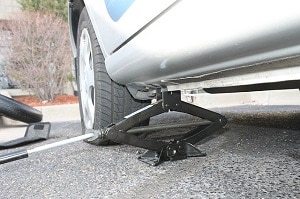Many new cars are now missing a spare tire and are coming from the factory equipped with tires or inflator kits that claim to make a spare tire unnecessary. We usually don’t think about the need for a spare tire until we need it. You should always have a spare tire in your vehicle because you never know when you’ll get a flat or puncture and be on the side of the road stranded. A spare tire and wheel provide you with a direct replacement, allowing you to become mobile again until you get a tire repair service.
Many spare tires for modern cars are smaller than normal tires to save on trunk space, gas mileage, weight, and cost, and they should not be driven on for long before replacement with a full-size tire. Don’t wait until you’re on the side of the road to invest in a spare tire. If your vehicle doesn’t come equipped with a spare, purchase a spare tire so you can safely replace a damaged tire, and travel to your nearest auto repair shop for proper service.
Types of Spare Tires
A Full-Size Spare Tire: A full-size spare is the same size as the other tires on the vehicle. The major advantage of having a full-size spare is that it’s not a temporary fix. Always have a tire rotation done on all your tires, including the spare if you have a full-size spare tire. Full-size spare tires are an exact replica of your existing tire and wheelset. Their only disadvantage is that they require the most storage space.
Temporary Full-Size Spare: A full-size temporary spare matches your vehicle’s original tire dimensions, but it isn’t the same in terms of tread depth and weight. These spares are lighter, which makes the tire easier to install. This spare is full size but does not match your regular tires.
Compact Temporary Spare Tire: A compact or donut spare is a temporary fix and should not be used to drive a significant number of miles. These tires are small and narrow, which takes up less space in your trunk but has shallow tread depth. Compact spares purpose is to save the day by getting you to an auto repair shop to have your tires replaced.
Folding Temporary Spare: These are foldable or collapsible tires that will require inflation before they are installed as a temporary spare tire.
A Run-Flat Tire: Run-flat tires are now becoming common for some car manufacturers to include instead of a spare tire. Rather than including a spare tire, these run-flat tires are built to withstand most road hazards, including punctures, and can continue to drive after a puncture for about 50 miles before needing to be replaced.
Flat tires are random occurrences that are beyond your control. Always keep some type of spare tire in your vehicle. You never know when you may get a puncture or flat tire and are stranded on an isolated highway. Regardless of the type of tire, your spare needs to be replaced sooner rather than later. If you use a temporary spare tire, you should not drive more than 50 miles, and no more than 50 miles per hour before replacing your spare tire. A spare tire is meant to get your vehicle safely to the nearest auto repair shop. Driving for long distances on a spare tire can potentially cause damage to other car parts, including the transmission. Inspect your spare when you get replacement tires and when performing monthly air pressure inspections.



